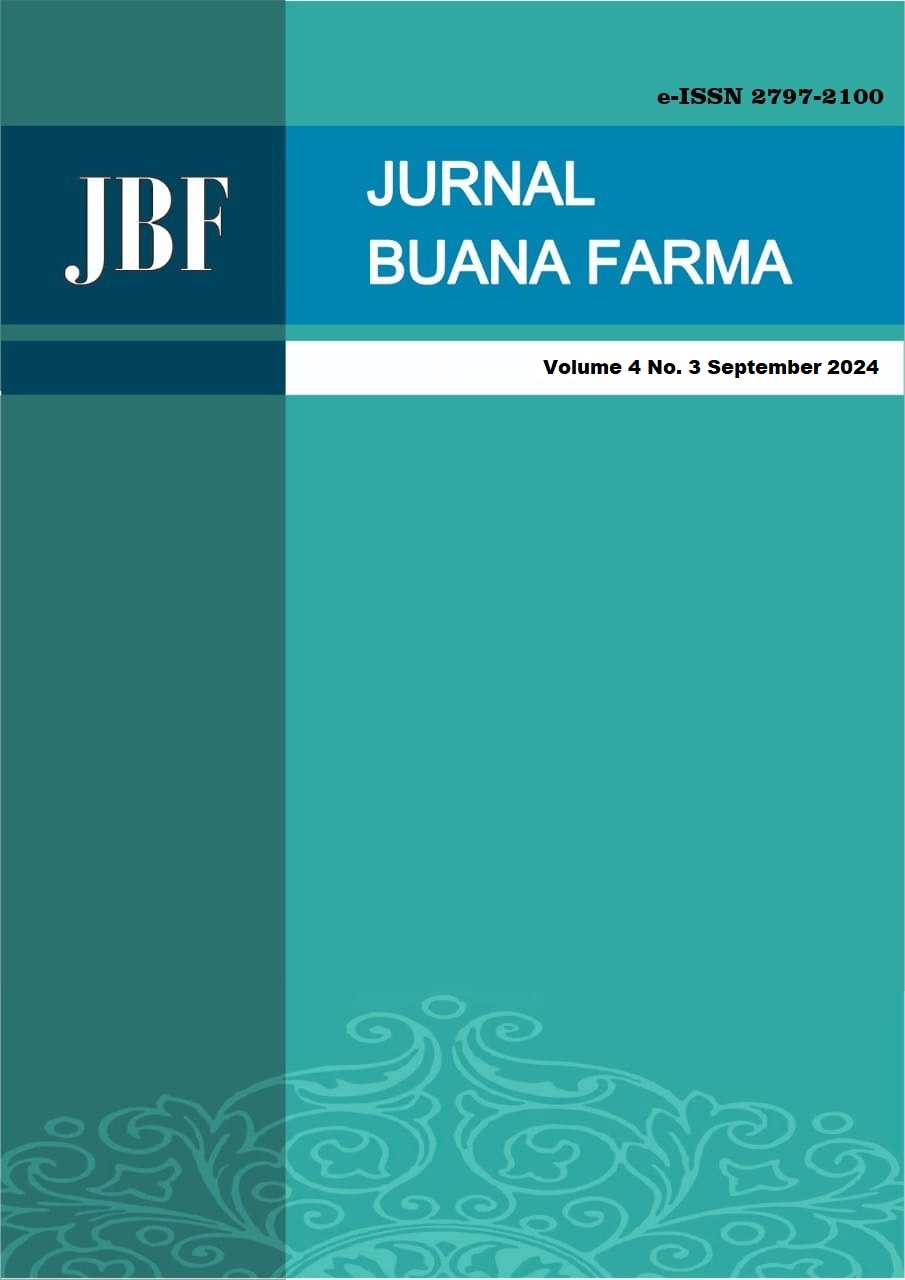REVIEW ARTIKEL: PENINGKATAN KELARUTAN SENYAWA OBAT ANTIMALARIA MENGGUNAKAN METODE MODIFIKASI KO-KRISTAL
Abstract
Malaria is an infectious disease caused by the Plasmodium parasite that infects humans through the bite of female Anopheles mosquitoes. Most antimalarial drugs have limitations in terms of solubility. Drug solubility is a very important parameter that determines the effectiveness of the drug, with good drug solubility, the drug can achieve optimal bioavailability and pharmacological effects, based on this, efforts are needed to overcome these problems in order to provide effective and efficient therapy to patients using existing antimalarial drugs that have been modified in their physicochemical properties so that their solubility increases. The purpose of this study was to review various studies that used the co-crystal modification method to increase the solubility of antimalarial drug compounds. This study was designed using the Narrative Review method, article searches were carried out using two databases, namely Google Scholar and PubMed, with the keywords "Co-crystal" OR "Antimalaria". In this study, 7 articles were found that met the inclusion and exclusion criteria. The selected articles are articles that discuss antimalarial drugs (artesunate, artemisinin, pyrimethamine) developed by the co-crystal method which experienced a multi-fold increase in solubility compared to its pure preparation. The co-crystal method can be a solubility enhancing solution for antimalarial drugs that have low solubility in water, increasing the solubility of antimalarial drugs causes the bioavailability of the drug to increase, so that the drug can provide good therapeutic effects.
References
Achan, J. et al. (2018) ‘Malaria medicines to address drug resistance and support malaria elimination efforts’, Expert Review of Clinical Pharmacology. Taylor and Francis Ltd, pp. 61–70. Available at: https://doi.org/10.1080/17512433.2018.1387773.
Adebayo, J.O. et al. (2020) ‘Enhancing the antimalarial activity of artesunate’. Available at: https://doi.org/10.1007/s00436-020-06786-1/Published.
Ainurofiq A. et al. (2021) ‘Review on Solubility Enhancement Methods for Poorly Water-Soluble Drugs’, Journal of Reports in Pharmaceutical Sciences. Wolters Kluwer Medknow Publications, pp. 137–147. Available at: https://doi.org/10.4103/jrptps.JRPTPS_134_19.
Alatas, F. et al. (2014) ‘Kelarutan dan Stabilitas Kimia Kompleks Didanosin dengan Nikotinamid atau L-Arginin.’, Jurnal Sains Materi Indonesia, 15(2), pp. 94–102. Available at: http://jusami.batan.go.id.
Alatas, F. et al. (2020) Kelarutan dan Aktivitas Antimalaria Ko-Kristal Pirimetamin-Ibuprofen Solubility and Antimalarial Activity of Pyrimethamin-Ibuprofen Co-Crystal, Pharmaceutical Journal of Indonesia.
Alatas, F. et al. (2022) Identifikasi Pembentukan Ko-Kristal Triklabendazol-Asam Oksalat dan Uji Kelarutannya.
Alatas F. Rani S and Dolih G. (2018) ‘Peningkatan Kelarutan Obat Malaria Melalui Ko-Kristalisasi dengan Asam Malat’.
Ansari, M.J. (2019) ‘An overview of techniques for multifold enhancement in solubility of poorly soluble drugs’, Current Issues in Pharmacy and Medical Sciences. Sciendo, pp. 203–209. Available at: https://doi.org/10.2478/cipms-2019-0035.
Belete, T.M. (2020) ‘Recent progress in the development of new antimalarial drugs with novel targets’, Drug Design, Development and Therapy, 14, pp. 3875–3889. Available at: https://doi.org/10.2147/DDDT.S265602.
Bhattacharya, Biswajit., et al. (2020) ‘Screening, crystal structures and solubility studies of a series of multidrug salt hydrates and cocrystals of fenamic acids with trimethoprim and sulfamethazine’, Journal of Molecular Structure, 1199. Available at: https://doi.org/10.1016/j.molstruc.2019.127028.
Chettri, A. et al. (2024) ‘Pharmaceutical co-crystals: A green way to enhance drug stability and solubility for improved therapeutic efficacy’, Journal of Pharmacy and Pharmacology. Oxford University Press, pp. 1–12. Available at: https://doi.org/10.1093/jpp/rgad097.
Cowman, A.F. et al. (2016) ‘Malaria: Biology and Disease’, Cell. Cell Press, pp. 610–624. Available at: https://doi.org/10.1016/j.cell.2016.07.055.
Dagen, M. (2020) ‘History of malaria and its treatment’, in Antimalarial Agents: Design and Mechanism of Action. Elsevier, pp. 1–48. Available at: https://doi.org/10.1016/B978-0-08-101210-9.00001-9.
Diagana, T.T. (2015) ‘Supporting malaria elimination with 21st century antimalarial agent drug discovery’, Drug Discovery Today. Elsevier Ltd, pp. 1265–1270. Available at: https://doi.org/10.1016/j.drudis.2015.06.009.
Fazlan Ahmadi (2019) ‘Pengaruh Pembentukan Ko-Kristal Pirimetamin- Asam Tartrat Terhadap Kelarutan dan Laju Disolusi Obat Anti Malaria Pirimetamin’.
Ferdiansyah, R. et al. (2021) ‘Review: The Effect of Cocrystal Formation Using Carboxylic Acid Coformer with Solvent Evaporation and Solvent Drop Grinding Methods on Bioavailability of Active Substances’. Available at: www.journal.uniga.ac.id.
Gracesella, C. dan and Sopyan, I. (2016) Ko-Kristal di Bidang Farmasi: Review Jurnal.
Guo, M. et al. (2021) ‘Pharmaceutical cocrystals: A review of preparations, physicochemical properties and applications’, Acta Pharmaceutica Sinica B. Chinese Academy of Medical Sciences, pp. 2537–2564. Available at: https://doi.org/10.1016/j.apsb.2021.03.030.
Hairunnisa., Iyan Sopyan. and and Doli Gozali (2019) ‘Cocrystal: Nocotinamide as the Coformer’. Available at: www.journal.uniga.ac.id.
Huang, Y. et al. (2014) ‘Baicalein-nicotinamide cocrystal with enhanced solubility, dissolution, and oral bioavailability’, Journal of Pharmaceutical Sciences, 103(8), pp. 2330–2337. Available at: https://doi.org/10.1002/jps.24048.
Indra (2015) ‘Prediksi Sifat Mekanik Kokristal Ketakonazol dengan Asam Adipat’.
Jagtap, S. et al. (2018) Solubility Enhancement Technique: A Review.
Kaur, M. et al. (2021) Artemisinin Cocrystals for Bioavailability Enhancement: Part 2. In-vivo Bioavailability and PBPK Modelling.
Kinansi, R.R., Mayasari, R. and Pratamawati, D.A. (2018) ‘Pengobatan Malaria Kombinasi Artemisinin (ACT) di Provinsi Papua Barat Tahun 2013’, pp. 43–54. Available at: https://doi.org/10.22435/blb.v13i1.255.
Kumar, S. and Singh, P. (2016) ‘Various techniques for solubility enhancement: An overview The Pharma Innovation Journal 2016; 5(1): 23-28 Various techniques for solubility enhancement: An overview’. Available at: https://www.researchgate.net/publication/326225390.
Kuminek, G. et al. (2016) ‘Cocrystals to facilitate delivery of poorly soluble compounds beyond-rule-of-5’, Advanced Drug Delivery Reviews. Elsevier B.V., pp. 143–166. Available at: https://doi.org/10.1016/j.addr.2016.04.022.
Milner, D.A. (2018) ‘Malaria pathogenesis’, Cold Spring Harbor Perspectives in Medicine, 8(1). Available at: https://doi.org/10.1101/cshperspect.a025569.
Nanda, A. (2017) Pharmaceutical Cocrystals: An Overview. Available at: www.ijpsonline.com.
Ngilirabanga, J.B. and Samsodien, H. (2021) ‘Pharmaceutical co‐crystal: An alternative strategy for enhanced physicochemical properties and drug synergy’, Nano Select, 2(3), pp. 512–526. Available at: https://doi.org/10.1002/nano.202000201.
Nugrahani, I. and Parwati, R.D. (2021) ‘Challenges and progress in nonsteroidal anti-inflammatory drugs co-crystal development’, Molecules. MDPI AG. Available at: https://doi.org/10.3390/molecules26144185.
Pandey, S.K. et al. (2023) ‘Drug Development Strategies for Malaria: With the Hope for New Antimalarial Drug Discovery—An Update’, Advances in Medicine, 2023, pp. 1–10. Available at: https://doi.org/10.1155/2023/5060665.
Partogi, T. et al. (2014) Preparasi dan Karakterisasi Polimorfisme Obat Anti Malaria Artesunat, Jurnal Sains Materi Indonesia. Available at: http://jusami.batan.go.id.
Plöger, G.F. et al. (2018) ‘Biowaiver Monographs for Immediate Release Solid Oral Dosage Forms: Proguanil Hydrochloride’, Journal of Pharmaceutical Sciences. Elsevier B.V., pp. 1761–1772. Available at: https://doi.org/10.1016/j.xphs.2018.03.009.
Putri Peratiwi Riskia. et al. (2016) ‘Pengaruh Pembentukan Ko-Kristal Pirimetamin-Asam Fumarat Terhadap Kelarutan dan Laju Disolusinya’, 4(1), pp. 31–36.
Putri, S.S., Darusman, F. and Hidayat, A.F. (2023) ‘Pembentukan Kokristal Sebagai Upaya Peningkatan Kelarutan dan Laju Disolusi Obat BCS Kelas II’, Bandung Conference Series: Pharmacy, pp. 63–71. Available at: https://doi.org/10.29313/bcsp.v3i2.7497.
Sathisaran, I. and Dalvi, S.V. (2018) ‘Engineering cocrystals of poorlywater-soluble drugs to enhance dissolution in aqueous medium’, Pharmaceutics. MDPI AG. Available at: https://doi.org/10.3390/pharmaceutics10030108.
Setyawan, D., S.R., Y.H., P. (2014) ‘Preparation And Characterization Of Artesunate - Nicotinamide Cocrystal By Solvent Evaporation And Slurry Method’, Asian Journal of Pharmaceutical and Clinical Research, 7(1): 62-65.
Seyto Wibowo, F.A.W.A. (2019) ‘Pengaruh Pembentukan Ko-Kristal Pirimetamin – Asam Sitrat Terhadap Kelarutan Dan Laju Disolusi Pirimetamin’.
Song, J.X., Chen, J.M. and Lu, T.B. (2015) ‘Lenalidomide-gallic acid cocrystals with constant high solubility’, Crystal Growth and Design, 15(10), pp. 4869–4875. Available at: https://doi.org/10.1021/acs.cgd.5b00699.
Srinivasulu Aitipamula and Reginald B.H.Tan (2017) ‘Pharmaceutical co-crystals: Crystal engineering and applications’, in Multi-Component Crystals: Synthesis, Concepts, Function. Walter de Gruyter GmbH, pp. 1–31. Available at: https://doi.org/10.1515/9783110464955-001.
Takabe, H. et al. (2018) ‘A repurposed drug for brain cancer: Enhanced atovaquone amorphous solid dispersion by combining a spontaneously emulsifying component with a polymer carrier’, Pharmaceutics, 10(2). Available at: https://doi.org/10.3390/pharmaceutics10020060.
Vemuri, V.D. and Lankalapalli, S. (2019) ‘Insight into concept and progress on pharmaceutical co-crystals: An overview’, Indian Journal of Pharmaceutical Education and Research, 53(4), pp. s522–s538. Available at: https://doi.org/10.5530/ijper.53.4s.147.
White, N.J. (2022) ‘Severe malaria’, Malaria Journal. BioMed Central Ltd. Available at: https://doi.org/10.1186/s12936-022-04301-8.
Wicht, K.J., Mok, S. and Fidock, D.A. (2020) ‘Molecular Mechanisms of Drug Resistance in Plasmodium falciparum Malaria’. Available at: https://doi.org/10.1146/annurev-micro-020518.
World Health Organization (2023) World malaria report 2022. Available at: https://www.wipo.int/amc/en/mediation/.
Yukich, J.O. et al. (2020) ‘Cost-effectiveness of focal mass drug administration and mass drug administration with dihydroartemisinin-piperaquine for malaria prevention in Southern Province, Zambia: Results of a community-randomized controlled trial’, American Journal of Tropical Medicine and Hygiene, 103(2), pp. 46–53. Available at: https://doi.org/10.4269/ajtmh.19-0661.













